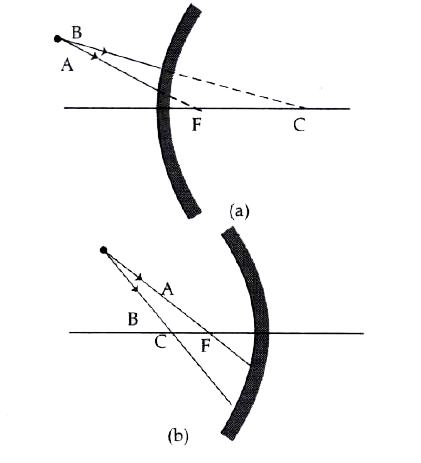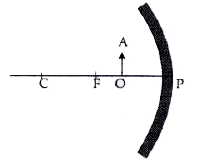Complete Solutions to EXERCISE 7(C) of chapter REFLECTION OF LIGHT of Class 9 book with complete answers and questions
| Class 9 | PHYSICS |
| Chapter | REFLECTION OF LIGHT |
| SELINA PUBLICATION | EXERCISE 7(C) |
| Number Of Questions | 54 |
| Academic Year | 2023-24 |
What is a spherical mirror?
View SolutionName the two kinds of spherical mirrors and distinguish between them.
View SolutionDefine the terms pole, principal axis and centre of curvature with reference to a spherical mirror.
View SolutionDraw suitable diagrams to illustrate the action of (i) concave mirror, and (ii) convex mirror, on a beam of light incident parallel to the principal axis.
View SolutionName the spherical mirror which (i) diverges (ii) converges the beam of light incident on it. Justify your answer by drawing a ray diagram in each case.
View SolutionDefine the terms focus and focal length of a concave mirror. Draw diagram to illustrate your answer.
View SolutionExplain the meaning of the terms focus and focal length in case of a convex mirror, with the help of , suitable ray diagram.
View SolutionState the direction of incident ray which after reflection from a spherical mirror retraces its path. Give a reason to your answer.
View Solution(i) Name the mirrors shown in fig a. and b.
(ii) In each case a. and b, draw the reflected rays for the given incident rays and mark focus by the symbol f.
View SolutionComplete the following diagrams in fig by drawing the reflected rays for the incident rays 1 and 2.

View SolutionComplete the following diagrams in Fig. by drawing the reflected ray for the incident rays A and B.

View SolutionState the two convenient rays that are chosen to construct the image by a spherical mirror for a given object? Explain your answer with the help of suitable ray diagrams.
View SolutionDraw a ray diagram to show the formation of image by a concave mirror for an object placed between its pole and focus. State three characteristics of the image.

View SolutionDraw a ray diagram to show the formation of image by a concave mirror for an object beyond its centre of curvature. State three characteristics of the image.
View SolutionDraw the image formed by a convex mirror when the object is kept in front of the mirror and write the characteristics of the image.
View SolutionName the mirror which always produces an erect and virtual image. How is the size of image related to the size of object?
View Solution(a) For what position of object, the image formed by a concave mirror is magnified and erect?
(b) State whether the image in part (a) is real or virtual?
View Solution(a) For what position of object, the image formed by a concave mirror is magnified and erect?
(b) State whether the image in part (a) is real or virtual?
View SolutionState the position of object for which the image formed by a concave mirror is of same size.
View SolutionWrite two more characteristics of the image.
View SolutionWhat is a real image?
View SolutionWhat type of mirror can be used to obtain a real image of an object?
View SolutionDoes the mirror mentioned in part b. form real image for all locations of the object?
View SolutionWrite the position and nature of the image formed in a concave mirror if the object is kept (a) at infinity (b) at F (c) between F and C (d) at (e) beyond C (f) between F and P.
View SolutionName the kind of mirror used to obtain:
a. a real and enlarged image
b. a virtual and enlarged image
c. a virtual and diminished image
d. a real and diminished image
View SolutionHow is the focal length of a spherical mirror related to its radius of curvature?
View SolutionWrite the spherical mirror's formula and explain the meaning of each symbol used in it.
View SolutionWhat is meant by magnification ? Write its expression. What is its sign for the a. real b. virtual, image?
View SolutionWhat may be the maximum distance of the image in a convex mirror can be obtained? What will be the location of object then?
View SolutionUpto what maximum distance from a concave mirror, the image can be obtained ? What will be the location of object for it?
View SolutionYou are provided with (a) a plane mirror, (b) a convex mirror and ( c ) a concave mirror.
How will you distinguish between them, without touching them?
View SolutionState two uses of a concave mirror.
View SolutionState the kind of mirror used
a. by a dentist, b. as a search light reflector.
View Solution(a) When a concave mirror is used as a shaving mirror, where is the person.s face in relation to the focus of mirror?
(b) State three characteristics of the image seen in part (a).
View SolutionState three characteristics of the image seen in part a.
View SolutionA mirror which is always used as a rear view mirror for vehicles is :
View SolutionWhy does a driver use a convex mirror instead of a plane mirror as arear view mirror? Illustrate your answer with the help of a ray diagram.
View SolutionFor an incident ray directed towards centreof curvature of a spherical mirror, the reflected ray:
View SolutionThe image formed by a convex mirror is
View SolutionName the kind of spherical mirror used to obtain : A real and enlarged image
View SolutionThe radius of curvature of a convex mirror is 40 cm. Find its focal length.
View SolutionThe focal length of a concave mirror is 10 cm. Find its radius of curvature.
View SolutionAn object of height 2 cm is placed at a distance 20cm in front of a concave mirror of focal length 12 cm. Find the position, size and nature of the image
View SolutionAn object is placed at 4 cm distance in front of a concave mirror of radius of curvature 24 cm. Find the position of image. Is the image magnified?
View SolutionAt what distance from a concave mirror of focal length 25 cm should an object be placed so that the size of image is equal to the size of the object.
View SolutionAn object 5 cm high is placed at a distance 60 cm in fornt of a concave mirror of focal length 10 cm. Find (i) the position and (ii) size, of the image.
View SolutionA point light source is kept in front of a convex mirror at a distance of 40 cm. The focal length of the mirror is 40 cm. Find the position of image.
View SolutionWhen an object of height 1 cm its kept at a distance 4 cm from a concave mirror, its erect image of height 1.5 cm is formed at a distance 6 cm behind the mirror. Find the focal length of mirror.
View SolutionAn object of length 4 cm is placed in front of a concave mirror at distance 30 cm. The focal length of mirror is 15 cm. a. Where will the image form? B. What will be the length of image?
View SolutionA concave mirror forms a real image of an object placed in front of it at a distance 30 cm, of size three times the size of object. Find a. the focal length of mirror b. position of image.
View SolutionA concave mirror forms a virtual imageof size twice that of the object placed at a distance 5 cm from it. Find: a. the focal length of the mirror b. position of image.
View SolutionThe image formed by a convex mirroris of size one third the size of object. How are u and v related?
View SolutionThe erect image formed by a concave mirror is of size double the size of object. How are u and v related?
View SolutionThe magnification for a mirror is -3. How are u and v related?
View Solution
EXERCISE 7(C) questions and complete solutions for chapter REFLECTION OF LIGHT of ICSE of Class 9